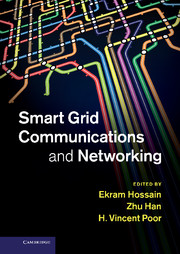Book contents
- Frontmatter
- Contents
- List of contributors
- Preface
- Part I Communication architectures and models for smart grid
- Part II Physical data communications, access, detection, and estimation techniques for smart grid
- Part III Smart grid and wide-area networks
- Part IV Sensor and actuator networks for smart grid
- 11 Wireless sensor networks for smart grid: research challenges and potential applications
- 12 Sensor techniques and network protocols for smart grid
- 13 Potential methods for sensor and actuator networks for smart grid
- 14 Implementation and performance evaluation of wireless sensor networks for smart grid
- Part V Security in smart grid communications and networking
- Part VI Field trials and deployments
- Index
11 - Wireless sensor networks for smart grid: research challenges and potential applications
from Part IV - Sensor and actuator networks for smart grid
Published online by Cambridge University Press: 05 January 2013
- Frontmatter
- Contents
- List of contributors
- Preface
- Part I Communication architectures and models for smart grid
- Part II Physical data communications, access, detection, and estimation techniques for smart grid
- Part III Smart grid and wide-area networks
- Part IV Sensor and actuator networks for smart grid
- 11 Wireless sensor networks for smart grid: research challenges and potential applications
- 12 Sensor techniques and network protocols for smart grid
- 13 Potential methods for sensor and actuator networks for smart grid
- 14 Implementation and performance evaluation of wireless sensor networks for smart grid
- Part V Security in smart grid communications and networking
- Part VI Field trials and deployments
- Index
Summary
Introduction
The electrical grid is a critical infrastructure that could have a major impact on human lives, economics, and politics [1]. Hence, any instabilities related to the structural and operational characteristics of the existing power grid, equipment failures, blackouts, poor communication, and lack of effective monitoring of the infrastructure, create additional challenges to the power utilities due to the prospect of vast economic losses, customer dissatisfaction, inefficient electricity usage, and the huge amount of CO2 emissions. The rising costs of new infrastructure and maintaining existing ones, increasing energy demand, and a declining number of skilled personnel, will drive utilities to operate systems more dynamically and efficiently. The need for real-time monitoring and management of transmission and distribution systems will become increasingly important. Such systems can be realized by the utilization of various types of sensors, and possibly actuators (actors).
Sensor systems will help provide the required information to utilities to achieve the goal of dynamic efficiency. The real-time information acquired from these sensors can be analysed to diagnose problems early, serve as a basis for taking remedial action, and thereby reduce service outages. This will reduce lost revenue and minimize person hours required to locate and rectify faults. For example, the Northeast blackout of 2003 in the United States was widespread and adversely affected over 50 million people with a huge economic loss [2]. There are many components of the electrical grid that must be monitored by advanced sensor technologies based on a combination of measurements, such as voltage, current, overhead conductor sag, temperature profile of conductors, power quality disturbances, system frequency, etc. [3–6].
Information
- Type
- Chapter
- Information
- Smart Grid Communications and Networking , pp. 265 - 278Publisher: Cambridge University PressPrint publication year: 2012
